Sheila Willcox was a hero and in honour of International Women’s Day we salute her as a pioneer for women in the world of eventing, but she was also a woman of great style, the first of the British Eventing women to combine her riding career with a writing and media career. She died in June last year.
Story: Chris Hector Photos: Archives
Back in 2013, THM interviewed two British Olympians who won medals in London, and both of them, Carl Hester and Mary King, paid tribute to a remarkable pioneer in equestrian sport, Sheila Willcox.
Sheila was – along with Diana Mason – one of the first ‘glamour’ girls of eventing, which was not an unmixed blessing at the time, since as a woman she was denied the place that she undeniably deserved in the British Olympic Team.
Sheila Willcox was a pioneer in so many fields, and the habit of combining writing and riding, later to become a small industry in the days of Lucinda Green and Ginny Leng, also began with the publication in 1958, of Sheila’s book Three Days Running. Given that she was also writing for l’Année Hippique at the time, I have the feeling that she actually wrote the book herself without the aid of a ghost. It is exceptionally well written (especially since Sheila was 21 when she finished it), witty and insightful.
It’s also a charming book, and okay, no childhood can have been quite so blissful, but one thing is amazing and that is, Sheila’s ability to turn horses into winners. It began with her very first pony – Folly. In fact, the initial title for her book was Folly Began It.
Sheila was born in 1936 into a most un-horsey family: “entirely suburban, based on business and academic careers and given to rugger, tennis, golf and bridge-playing.”
That first pony was, of course, utterly unsuitable for a ten-year-old girl whose equestrian experience was with the ‘beach ponies’ at Lytham: un-broken and 18 months old! Somehow with the help of her brother, the pony was sufficiently rideable to be taken – at the age of two – to the local Agricultural Show.
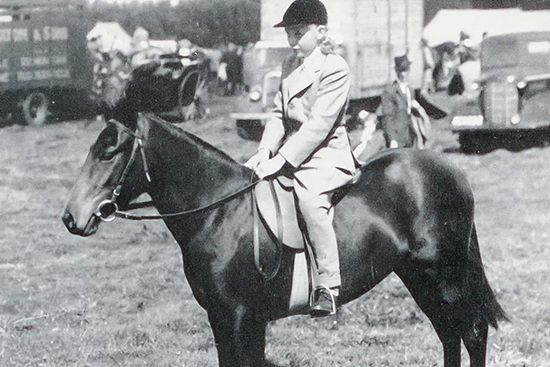 “Folly had her mane and tail washed and was given a special grooming. Then, with hooves blacked, she was proudly ridden by me to the show ground. The thought of a prize never entered my head, but to wear a number, to be called by name into the ring and walk, trot and canter round with the other ponies – this was halcyon bliss. An old man, with knowledgeable gleam in his eye, looked at us and said: ‘You can’t go into the ring like that.’ ‘Why not?’ said my father, all belligerent. ‘Well,’ said the old man, ‘the pony’s mane should be plaited.’ I looked with alarm at the smart hair-dos of the other children’s mounts and my heart sank. ‘Never mind,’ said the man, ‘we’ll hog it,’ and before our eyes he produced a large pair of scissors and proceeded to shave away what little mane there was. This performance must have put Folly into a trance, for she behaved like a veteran in the class. She was pulled in third, and finished second when number two disgraced himself by playing the bucking bronco. So I won my first rosette; no other has ever thrilled me so much, and at the same time I determined that no matter which branch of equestrianism I should eventually take up, I should strive to emulate the leaders.”
“Folly had her mane and tail washed and was given a special grooming. Then, with hooves blacked, she was proudly ridden by me to the show ground. The thought of a prize never entered my head, but to wear a number, to be called by name into the ring and walk, trot and canter round with the other ponies – this was halcyon bliss. An old man, with knowledgeable gleam in his eye, looked at us and said: ‘You can’t go into the ring like that.’ ‘Why not?’ said my father, all belligerent. ‘Well,’ said the old man, ‘the pony’s mane should be plaited.’ I looked with alarm at the smart hair-dos of the other children’s mounts and my heart sank. ‘Never mind,’ said the man, ‘we’ll hog it,’ and before our eyes he produced a large pair of scissors and proceeded to shave away what little mane there was. This performance must have put Folly into a trance, for she behaved like a veteran in the class. She was pulled in third, and finished second when number two disgraced himself by playing the bucking bronco. So I won my first rosette; no other has ever thrilled me so much, and at the same time I determined that no matter which branch of equestrianism I should eventually take up, I should strive to emulate the leaders.”
more follows
More ponies followed, and each time, success seemed to follow. Young Miss Willcox was indeed a winner. In her “last season as a juvenile… the problem of what to do next was all-important. My parents were quite adamant that I should not join the ranks of the showjumpers, for they considered that the time had come for me to assume a more lady-like demeanour. It was decided, then, that a show-hack, that mannequin of the horse world, should be found for me.”
Sure enough, the five-year-old gelding in the rough was, 18 months later, now dubbed, Blythe Spirit, Champion Hack at the International Horse Show.
Sheila was nearly 18 when her true equestrian vocation was found: “Although I have never been to a Horse Trial, I felt most attracted to a competition demanding talent in three distinct directions. My experience with the ponies and show-hacks would stand me in good stead as far at the dressage and show-jumping phases were concerned, and I hoped that my ability to ride across country was something which could be developed.”
It would seem she was a natural riding cross country. Look at the photos, Sheila shares that quality with Bill Roycroft and Bill Steinkraus, of always being in balance with her horse…
After considerable searching a seven-year-old dun gelding was found. “His rather odd dun colour, the black mark along his spine and the lines on his front legs could all be traced as a legacy from his Highland pony grand-dam; for, though his sire is Thoroughbred, his dam was half-Arab and half-Highland. The mixture of breeds did not worry me in the slightest for personally I believe a little splash of common blood does no horses any harm and will perhaps add the calm temperament and sound sense that is often to be found lacking in the majority of Thoroughbred animals.”
The horse was High and Mighty – or as Sheila called him, Chips.
His dressage was improved with the aid of Henry Wynmalen’s book, Dressage.
“I would consult Mr Wynmalen’s book first, and then try to put into practice what I had learnt from his theory. I found his advice invaluable, and still look through its pages when I want to be sure of how to begin to teach a new exercise.”
It must have worked because the pair won their first official Horse Trials, a Novice at Hovingham Hall, and earned the comment from equestrian guru, Col Dorian Williams, that the horse was ready for ‘Horse Trials proper.’ High and Mighty was beginning to be noticed – Sheila received an offer to buy him from ‘an Australian’ and the British Horse Society suggested that she might ‘lend Chips for training as a Possible for the Olympic Team.’ It was the beginning of a theme that was to blight Sheila Willcox’s life, as at that time the Olympic Eventing Team was a men-only affair.
Sheila went back to training for the Pony Club team, and met up with Colonel Edy Goldmann, the trainer to whom she dedicated her own training book, The Event Horse, when she published it in 1973. In this era of hot house flowers with their round-the-clock/one-on-one training, it might be noted that when she visited Goldmann in 1955, this was ‘our first professional instruction’.
Edy Goldmann who was born in Zurich in 1896, the son of a wealthy silk manufacturer, was the first great eventing trainer in Great Britain, and his Cheshire Equestrian Centre, established in 1955, produced a startling number of top eventers.
There is a persistent myth that Sheila Willcox studied in Germany, not true, but in going to Goldmann she was tapping into the knowledge of one of Germany’s great dressage masters, Felix Bürkner.
“I worked under him for several years,” Col Goldmann told Ann Martin, when she interviewed him for her book, The Trainers, “He raised the standard of my own performance enormously and had a big influence on my riding from the point of view of Dressage. Although I rode at Richmond and at such international shows as Aachen, for Switzerland, I think the reason I eventually turned to training was that I was always more interested in style than actually winning.”
This was not an attitude that Sheila shared. Mary King in her autobiography remembers that after working for Sheila for six months, she became head girl and Sheila let her compete. At her very first Horse Trials, she finished second and third on her two horses and remembers being “so elated because it seemed incredible to have done that at my first affiliated event. Sheila was furious I hadn’t won. She said: “You just looked like a pony clubber.” I sat in the back of the lorry in disgrace on the way home as she drove at her customary irritable speed.”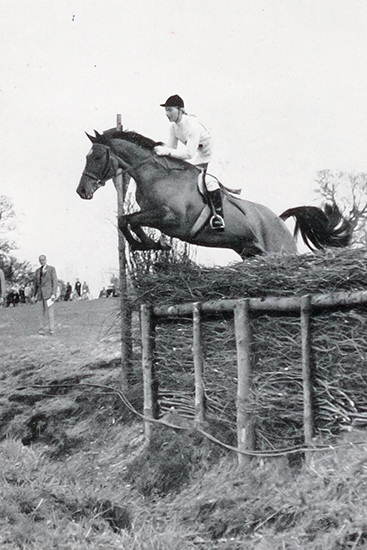
Sheila and High & Mighty – Badminton 1965
Col Goldmann remembered teaching the teenager: “Sheila Willcox came to me when she was 17, particularly wanting to improve her dressage. When she first came she brought High and Mighty and he was a very suitable horse for the job. Sheila’s quick rise to the top was aided by her complete single mindedness of purpose. When she has a target in mind nothing else matters other than its achievement. She has a sense of humour which is always a help, allied to the ability to work.”
The instruction helped, for at the prestigious Harewood Horse Trials Sheila and Chips were leading after the dressage. Although they lost points on the cross country, they finished in fourth place and were invited to join the squad of riders at Windsor, for possible inclusion in the British Team to go to the Turin International in October 1955.
On their way to victory at Badminton 1957 – Sheila and Chips
Sheila was selected, and while there were teams from France, Germany, Italy, Turkey, Switzerland and Great Britain, she was “the only girl competing against all male-opposition.” And yes, Sheila won!
In 1956, aged just 20, Sheila competed at her first Badminton. The pair were second to the great Col Frank Weldon and Kilbarry, after the dressage. Both Weldon and Willcox came home clear and with the maximum bonus points after the cross country, so going into the showjumping Weldon lead by 1.5 – a lead that Kilbarry retained, when both showjumped clear, and Sheila Willcox was second at her very first Badminton, but by the morning of the showjumping, she no longer owned Chips!
Several of the potential British team horses for the Olympic Games, to be held later that year in Stockholm, had fallen by the wayside, and there was enormous pressure on the Willcox family to sell the horse. In the end a fellow competitor – and selector – Ted Marsh came up with the solution. He would buy the horse and place him at the disposal of the Team but “also promised that if Chips returned from Stockholm safe and sound, then I could ride him in the following Spring Trials.”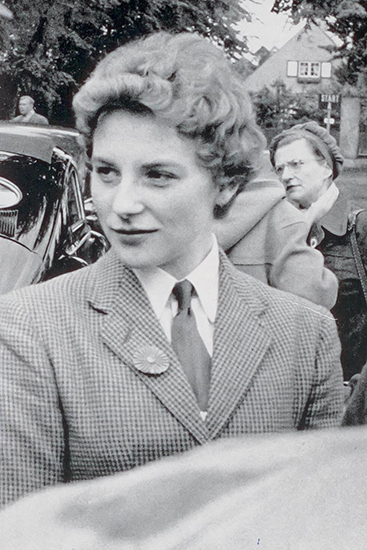
Once the horse arrived at the training camp at Windsor, he was found to be lame and not considered for selection. Sheila attended Stockholm as a spectator, vowing to buy back her Chips when she returned home…
Sheila was not just a spectator, she had been invited by the equestrian annual, l’Année Hippique, to comment on the action at the Olympic Games in Stockholm. Ms Willcox’s dressage was always a class act, and she was somewhat dismissive of the first phase in Stockholm:
“The dressage seemed even at this Olympic level, the poor relation in performance, enthusiasm and eagerness to the second and third day’s work. It surprised me to see so few horses truly on the bit, and impulsion and extension were conspicuous by their almost complete absence.”
The (all male) British team of Weldon, Rook and Hill took gold but obviously her omission from the team purely because of her sex, rankled with Sheila: “Harking back to the controversy over allowing women competitors in the three-day event, and without wanting to appear a militant feminist, I still think the element of danger is in ratio to intelligent riding, and that should an unlucky accident happen to a woman instead of a man, she will show equal fortitude and endurance, as well as possibly less sustained shock due to the relief of feminine tears. No one would be surprised to see me passing the finishing post crying bitterly and feeling much better for it, but it would cause something of a furore if Rook or Weldon came home dripping tears over Sissi or Kilbarry!”
Back home, Sheila bought back her horse and began to prepare him for the coming season. There was no sign of the lameness that had kept him out of the Stockholm team and they won their first Trial of the season – Melton Mowbray.
The sights were on Badminton again but this time there was an added dimension to the event, since it was decided to hold Sheila’s 21st birthday party in a hotel in Limpley Stoke, during the event. High and Mighty was leading after the dressage, and still in the lead after the cross country, and it was time to party.
“My party was due to begin at half-past eight in the evening so there was no time to spare, and I was rushed back to the hotel to recover spent energies and try to produce myself as out of a band-box to receive the guests with my parents… I had found a good band in the Midlands to play for the evening, and soon everyone was dancing and joining in the novelties. At midnight I was presented with an enormous key – another of Daddy’s carpentry efforts – and then the cake was cut and champagne flowed. The cake itself deserves special mention, for it was a work of art; the top showed a cross-country course, complete with castle, streams and undulating terrain, and there were 21 fences, each representing a year of my life, and a little model of Chips and me leaping safely over the last one. The party was to finish at half-past two, but at three o’clock we were still busy trying to shoo away the lingering few…”
Clear showjumping round next day of course, and the Badminton crown was Sheila’s!
To underline the unfairness of her omission from the Games team, Sheila won the Badminton title again with High and Mighty the next year, with a 22 point lead after dressage, widening to a 47 point lead by the end of the event. She described her cross country run in l’Année:
“This year Chips (High and Mighty) seemed to go round faster than ever. He was in and out of the tricky combinations in no time and whichever fences he found a little too big to jump, he banked…. He is not at all fast in actual speed, but his handiness and clever jumping make him more than a match for the fleet-of-foot. He is a horse in a million. By the time we reached the twenty-sixth fence, he was still going strongly but over the “Vicarage Ditch’ we landed heavily and were then facing the obstacle which had been haunting me since the course inspection. It was an awe-inspiring fence of gigantic rails over a cavernous ditch. The spread was enormous for any horse but a very free moving one, and as we rode into it, Chips was anything but free moving. At the take-off stride he checked and then we rose into the air from almost a standstill. It seemed an eternity before we landed on the far side, an eternity in which I was completely convinced that any second we should land in the gaping ditch below. But he was over safely, and in the stretch before the next fence he regained his wind. The rest of the course fell behind us without difficulty and we finished with the fastest time of the day, and bonus points nearly double that of the nearest competitor.”
Powering to a European Title, Sheila Wilcox and High and Mighty
Sheila takes up the story again in Three Days Running:
“Everyone at home was delighted with our success, and it was decided by the local Council that I should be invited to the Mayor’s Parlour and receive an inscribed crop to commemorate the occasion. What a shame that the one who really merited such attention could not taste all these fruits of victory; but then, after all, perhaps Chips would rather have been where he was, enjoying the luscious spring grass, and the unaccustomed freedom to wander at will, with a herd of cows and their master the bull for company, and nothing to do day after day but eat, sleep and eat again, and bear my appearance once a day when I went to vary his green diet with a bucket of oats.”
more follows
In October 1957, Sheila and High and Mighty were selected in the British team for the European Championships in Copenhagen. After the dressage, Sheila was in second place behind the German pair of Franco and August Lütke-Westhues, while the British team was in third behind Germany and Sweden.
Sheila was third out on the cross country course: “Colonel Weldon was there to see each member of the Team off on the cross country phase, and knew exactly what had befallen both Venture and Willie. He was about to tell me of the trouble there had been, and to advise me accordingly, but I implored him not to. At all these Trials I carry a picture of the course in my mind; of where I intend to go, and where to jump, and to hear of trouble or disaster at any particular fence is, to me, absolutely fatal. I simply must be allowed to ride the course as I have planned. This might seem rather silly to some people, but it is just a personal foible of mine, and neither my mother nor father would ever dream of telling me anything of the grief there had been.”
Sheila did have one problem on course: “The track to number ten was deep with mud and I had already decided to swing left under the trees in order to avoid this. Unfortunately there were many low branches and I had to crouch low on Chip’s neck and shut my eyes. He, too, must have been going with his eyes shut, for when I turned him at the last minute to the fence, he stopped dead.”
But even with the stop, the pair had the fastest time of the day and were the best performers over the course. His bonus score more than trebled his penalties, and while Sheila was still in second behind Lütke-Westhues, the gap had narrowed, it all depended on the final round of showjumping. High and Mighty had two down, but Franco had three, and Sheila was the new European Champion, and the British team had taken the title.
Sheila then retired High and Mighty but came back the next year to defend her Badminton title with the seven-year-old Airs and Graces, who had competed in his first three day event just six months previously! Three Badmintons in a row – no rider has matched this feat.
A fall in 1971 at the Tidworth Horse Trials left Sheila Willcox partially paralyzed and she gave up eventing, turning to dressage, and rode at Grand Prix level with Son and Heir.
Two years after her fall, Sheila Willcox recorded yet another first – the first Eventing training book. As Princess Anne noted in her forward: “To my certain knowledge there has never been a comprehensive book on the specific requirements of the event horse. I can think of no one better qualified to write such a book than Sheila Willcox…”
This book was to further widen the influence of this remarkable woman. The coach of the current gold medal eventing team, Christopher Bartle remarks:
“I was never directly exposed to Sheila’s teaching. She was successful just before I really got involved in the sport. But she did have an influence on my career in that I studied her system of preparing her event horses as set out in her book and that was my bible in particular in relation to getting horses fit for eventing.”
“She was I understand a stickler for detail and consistency and that appeals to me. Whilst some details have changed in respect of the modern sport and its increased technicalities in all phases, the underlying theme and basic system for conditioning the horse is as relevant now as it was in her day.”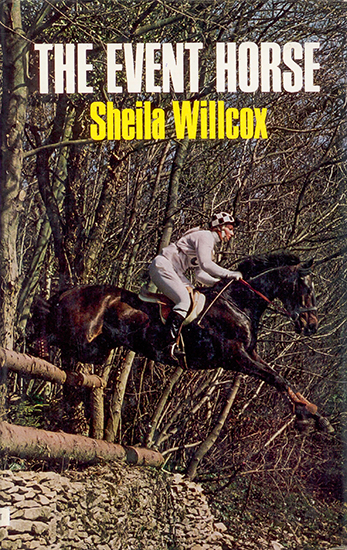
As any reading of The Event Horse will confirm.
Sheila sets out her aim elegantly:
“The training of an Event horse throughout the various stages to the ultimate perfect article is a great responsibility and challenge. The whole aim is to produce a horse schooled to medium dressage standard, with good, basic paces and extension and able to perform accurately and easily the more advanced movements of counter canter, work on two tracks, and pirouettes at the walk. Above all, the horse must have attained the second stage of dressage training: self-carriage. His hind legs must be well under him and his forehand light and free. His basic paces must be pure at all times and he must be perfectly straight. He must achieve outstanding rhythm, bordering on cadence. He must show correct length bend and be accurate and obedient. Most important of all, he must do this with presence and show that he enjoys his work and that he neither resents nor begrudges his whole-hearted co-operation. It is perfectly possible to train a horse to this standard without boring him in the process, and it is a poor tribute to dressage trainers that so many people believe a horse schooled for dressage becomes too set and stilted for the rider’s genuine enjoyment. My aim is to have a horse which is an absolute delight to ride. Easy to manœuvre because he is light in hand and immediately responsive to the slightest aid. I do not want an automaton but a confident, free-striding and happy horse with whom I can communicate and merge into a perfect partnership.”
As Christopher Bartle says, the book outlines a system that would be “as relevant now as it was in her day.”
Sheila Willcox takes out the ‘Little Badminton’ trophy in 1964 with Glenamoy
It was certainly a system that stood Mary King in good stead. Mary at just 16 and straight out of school found work with Sheila. It was tough going:
“My days would begin at 5.30am and, before I even got on a horse, I realised that the stable management was extraordinarily thorough. Mucking out was a very strict procedure; you had to move the straw back completely and the bed had to be completely flat and perfect. The bedding in the stable doorways had to be square and swept back and no more than one pile of poo was allowed in a stable at any time. Windows were washed inside and out once a week and there couldn’t be a cobweb in sight.”
“Horses had their own individual grooming kits, including face flannels. You always started grooming on the left side, at the side of the horse’s neck, using your left hand, and then your right hand for the right side. You used a soft dandy brush first; then a body brush and curry comb scraped together in the old-fashioned way.”
“Then we had to get out the horse’s individual stable rubber and make it into a thick square and, using your right hand on the left side of the horse, strap 20 times on the neck muscle, 20 times on the elbow, while looking to the back of the horse, 20 times at the back of the knee, then on the quarters and hocks. It not only built up the horse’s muscles and crest, but also your own – I developed whopping muscles.”
“Then you fetched warm water and wiped the horse’s eyes, nose, mouth and inside ears, then the dock and sheath area, always rinsing in between. The hooves were oiled inside and out, and then rugs, which had to be folded in a particular way, put back on. If a horse came out of the stable with straw in its tail, you had to put ten pence in a box.”
“Once a week, bandages and summer sheets were washed. The summer sheet had to be ironed, and the stable bandages and even the tapes. Then you folded the tape inside the bandage before rolling it up. Tack was cleaned every day.”
“Horses were never allowed to be untied in the stable if they didn’t have bandages on – they were always clad in gamgee and bandages, and Sheila was very particular as to how this was done. All this was very new to me – I’d never even used rugs and bandages before.”
“I’d never clipped a horse, either, and I remember her praising me after my first time, as I did manage to get a good finish. She seldom said “well done”, so when she did, it meant so much. If she walked by your stable, and kept going without saying anything, that could be considered praise itself. But if she spotted a bit of straw in the gravel, which we raked regularly, she’d just point silently and disapprovingly, and you’d scuttle along and pick it up.”
Sheila and Fair and Square, giving the Trakehner plenty of air…
It might have been tough, but it was also an essential stepping stone in Mary’s emergence as an international eventing star:
“I suppose I’m old-fashioned, but I’m not sure you can properly progress and really learn until you’ve been scared – or at least very respectful – of someone. At Sheila’s, I didn’t speak until I was spoken to and always did as I was told without arguing. It might sound a bit feeble on my part, but it turned out to be fantastic training and the broad base on which I have built my career. Nowadays, a lot of riders start off in their own yards and, as a result, reach the top of their pyramid too early and don’t really get anywhere.”
“I was lucky enough to get a lot of riding at Sheila’s, though I was never allowed to ride a horse in the school without her being there, and she was constantly critical. My local teenage successes had made me think I must be pretty good, but soon after my arrival at Sheila’s the reality hit home that I was, in fact, hopeless. It took me a week to learn to ride a 20 metre circle in trot as she wanted, and soon I was permanently in a state of upset at my inability to get anything right.”
“I’d be frustrated that the horse wouldn’t go in my hand; and then Sheila would get on it with her paralysed leg and it would go beautifully for her. I wasn’t naturally a good jumping rider, I couldn’t see a stride and had no natural grasp of placing a horse in front of the fence. I’d forever miss my jerk and she’d get furious. She’d get other riders, like Mark Phillips and Richard Walker, to get on the horse and I’d watch them helplessly, seeing them canter rhythmically and arrive at the same spot every time in a way that was completely elusive to me.”
“I got to know the great showman Robert Oliver, who came over regularly, and I still have a soft spot for him because he would actually come up and say if you’d ridden well. Sheila, by contrast, would criticise me to deflect from the horse’s defects, and I had to just take it. There were many tearful nights because I was permanently frustrated that I wasn’t good enough for her, but I was determined to never let it show. There was no going back.”
Badminton 1956 – Jumping into the Coffin, with Chips, how perfect is the rider position?
But eventually, Mary, at 18 years old, decided that it was time to move on. Ms Willcox was not amused:
“The day I left I took her a big bunch of flowers, but she wasn’t interested, and I was very shaken. My experiences there affected me mentally and I dreamed about Sheila’s yard every night for quite a long time. But I have come to realise that I’d had a start in my riding life that probably no other person of my generation had been privileged to know, and it toughened me up in a way which has stood me in good stead ever since. Quite honestly, everything else in life has seemed a doddle since then.”
Sheila Willcox has retreated from public life, although it is rumoured that she has written an autobiography which should prove fascinating reading. It is however more than a little sad, that at a time we are rightly celebrating the British equestrian triumphs at the London Games, that this remarkable woman, who laid the basis for the British rennaissance, should not be accorded the accolades she so richly deserves…
This article first appeared in the March 2013 issue of THM.
Sheila Wilcox died in June 2017
Want to breed an eventer? You can – check out the range of stallions available from IHB and find the right one to compliment your mare: www.ihb.com.au
For more on how to breed a medal winning eventer:
http://www.horsemagazine.com/thm/2013/10/breeding-eventers-blood-will-out/
http://www.horsemagazine.com/thm/2014/12/friedrich-butt-breeding-eventers/
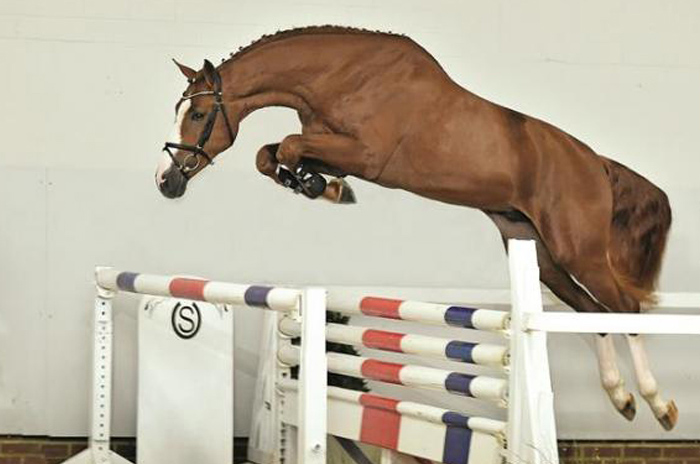 Balou Pagio
Balou Pagio
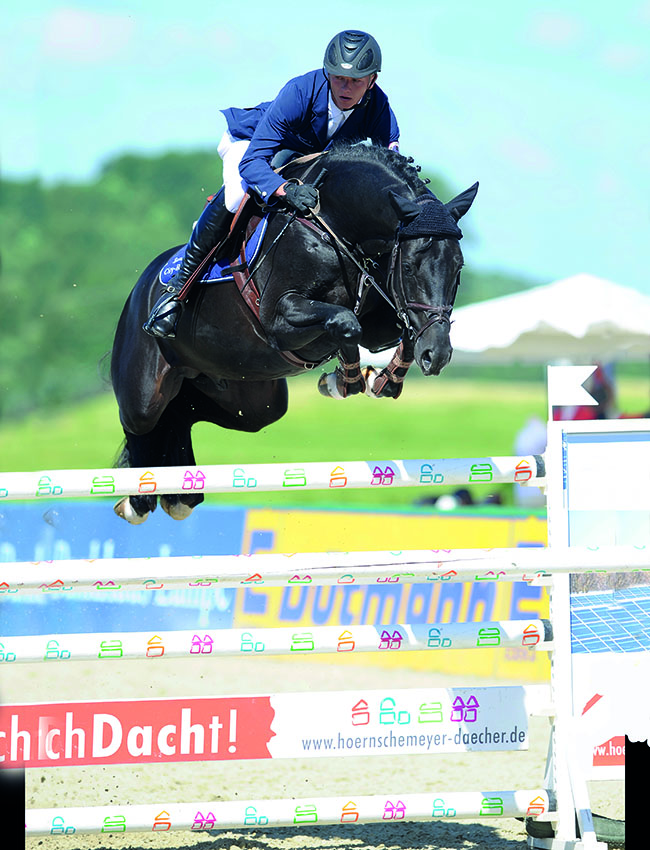
Diarado


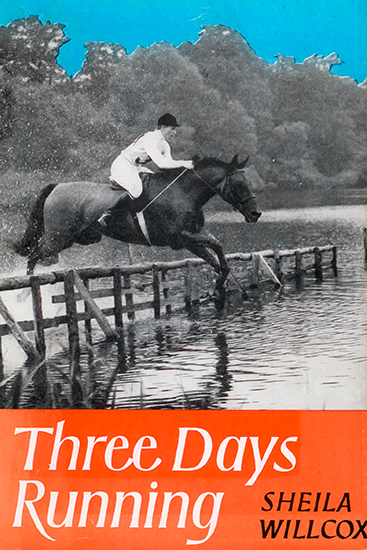
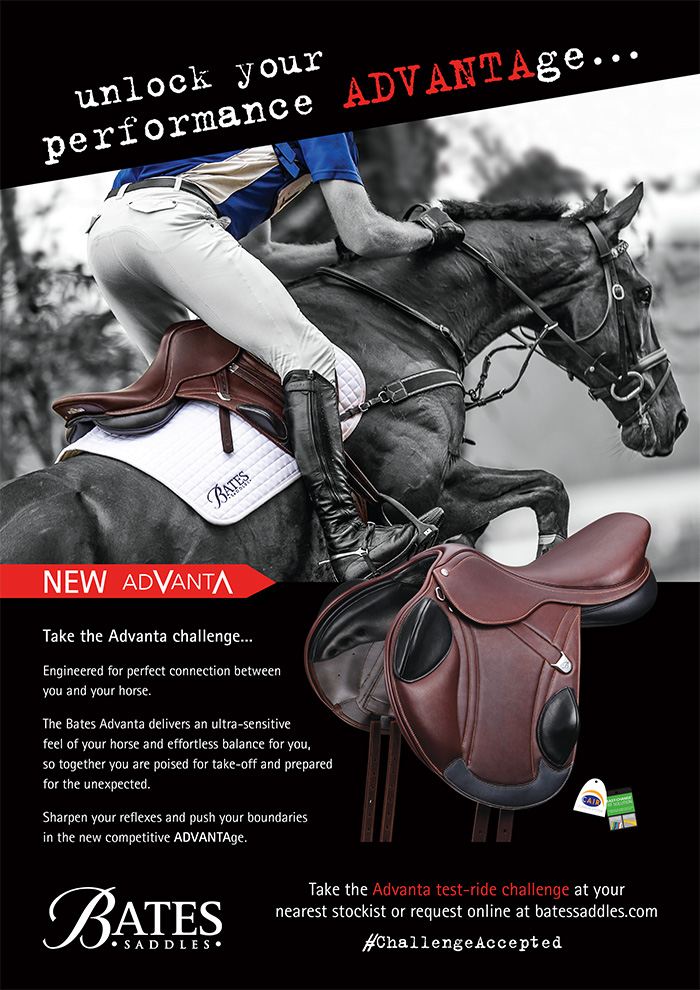
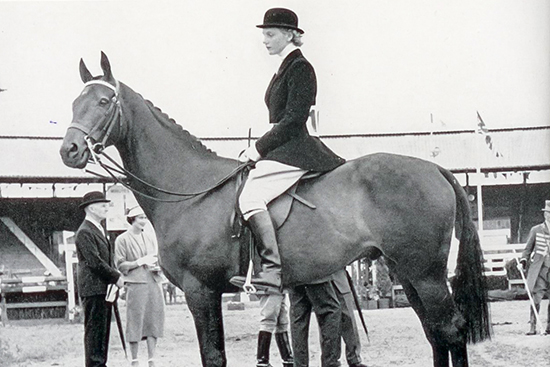
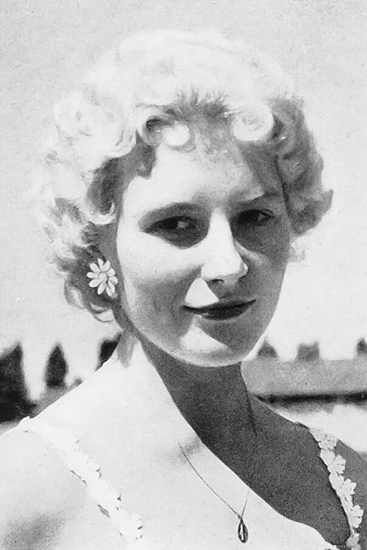

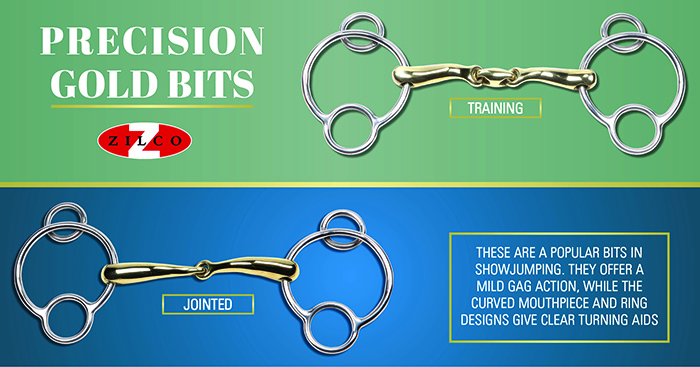

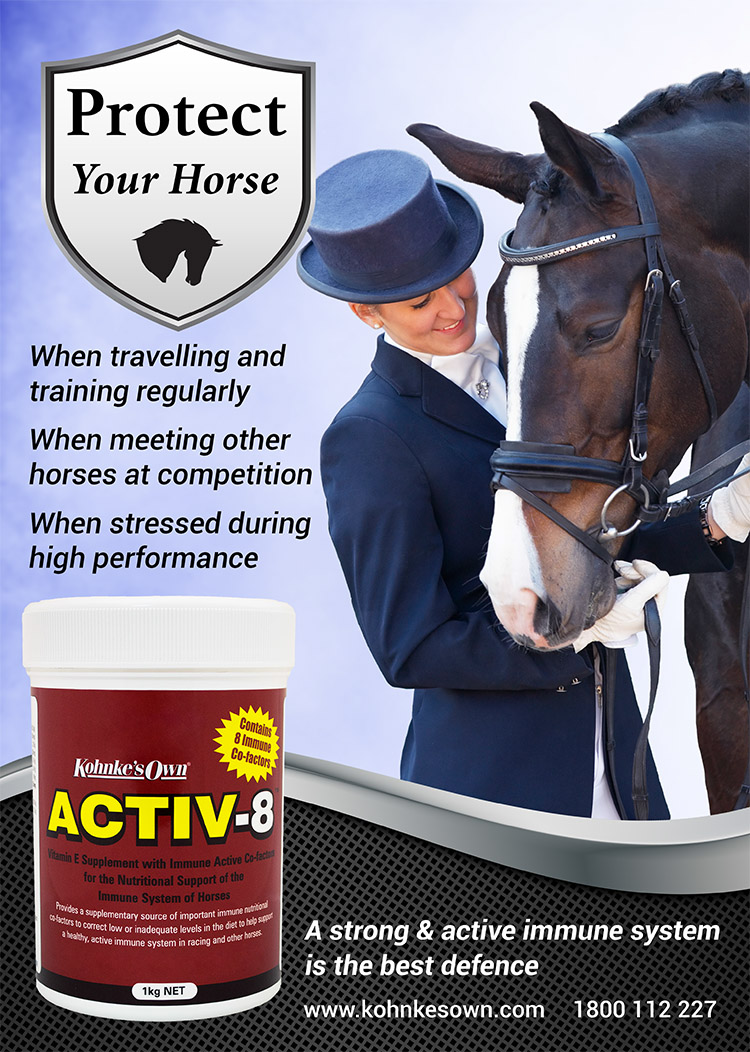


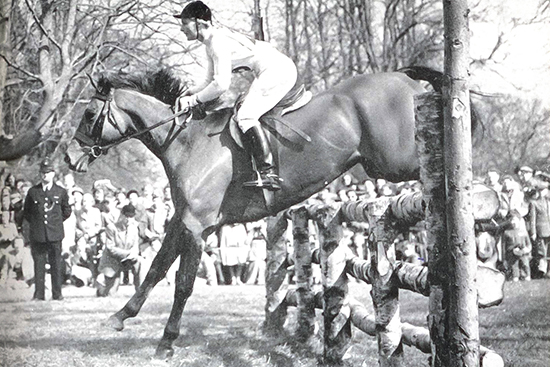
It’s Willcox.